Civic Crowdfunding Platforms - Psychological Empowerment Report
VerifiedAdded on 2020/07/22
|26
|12553
|96
Report
AI Summary
This report investigates civic crowdfunding platforms, focusing on their role as enablers and potential impediments to psychological empowerment and well-being of citizens. It begins with an introduction to the topic, including a problem statement highlighting the transformative influence of social media and the challenges faced by the public sector. The literature review explores crowdsourcing, crowdfunding, and civic crowdfunding, along with concepts of psychological citizen empowerment and well-being. The report then outlines the research design, emphasizing the need to understand how civic crowdfunding platforms improve citizen well-being and empowerment, and the barriers they face. The study aims to compare features of different platforms, analyze their impact, and provide insights into the opportunities and challenges they present. The report underscores the potential of civic crowdfunding to enhance citizen engagement and contribute to the success of civic projects, while also acknowledging the need for further research to understand the technology's impact on users. It aims to provide guidance for future platform design and insights for government entities and organizations, as well as the beneficiaries of the funds raised.
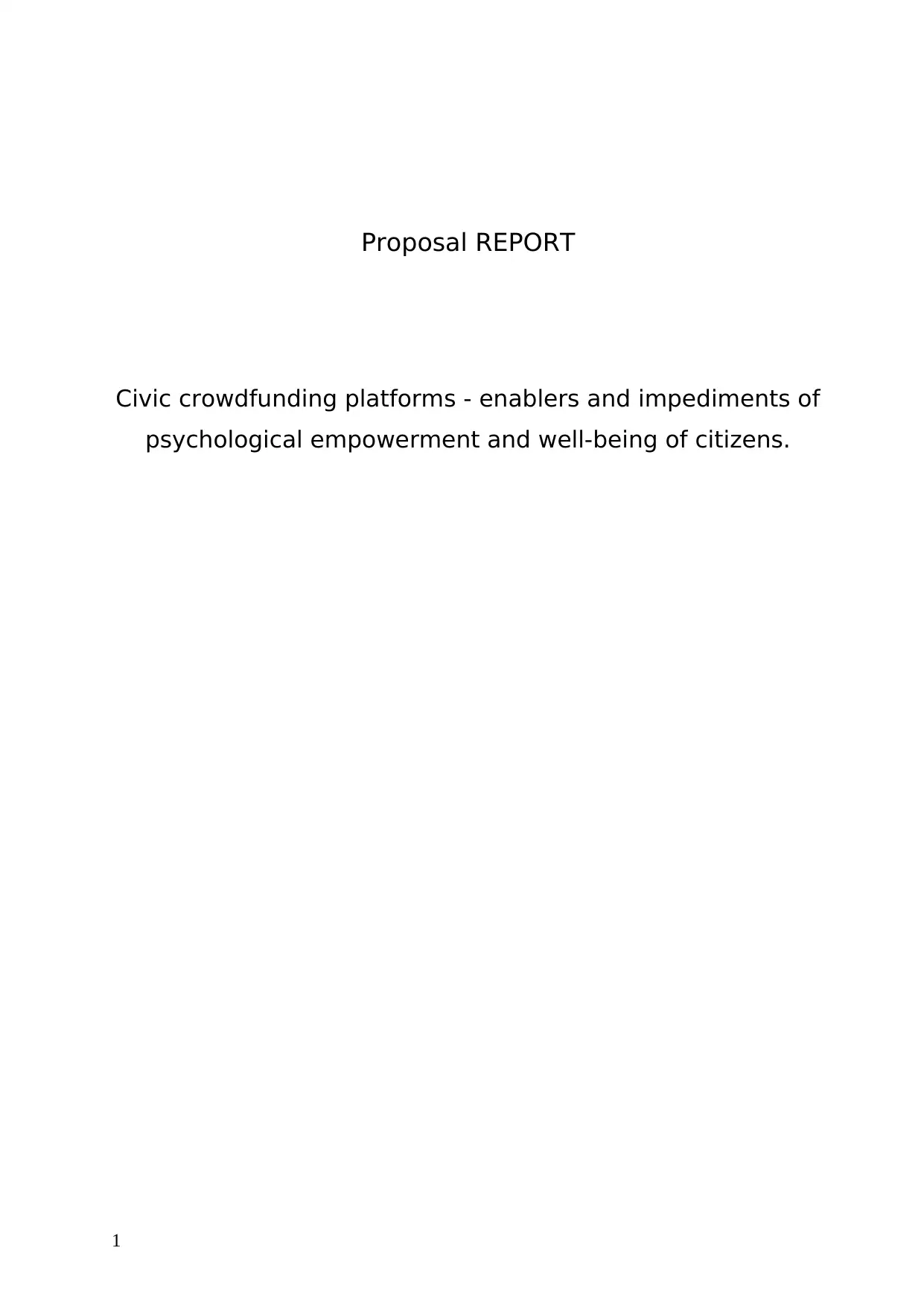
Proposal REPORT
Civic crowdfunding platforms - enablers and impediments of
psychological empowerment and well-being of citizens.
1
Civic crowdfunding platforms - enablers and impediments of
psychological empowerment and well-being of citizens.
1
Paraphrase This Document
Need a fresh take? Get an instant paraphrase of this document with our AI Paraphraser
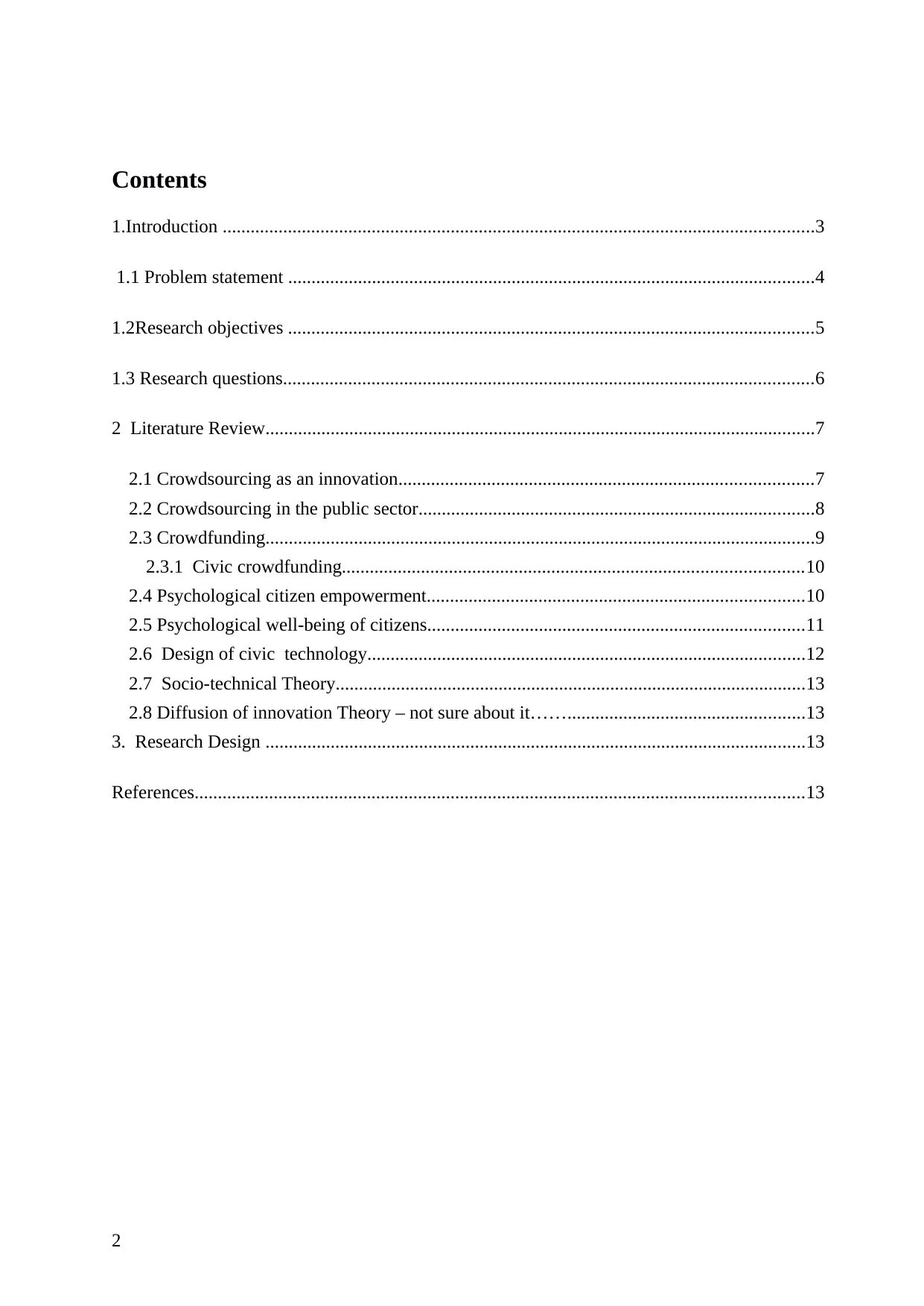
Contents
1.Introduction ...............................................................................................................................3
1.1 Problem statement .................................................................................................................4
1.2Research objectives .................................................................................................................5
1.3 Research questions..................................................................................................................6
2 Literature Review......................................................................................................................7
2.1 Crowdsourcing as an innovation.........................................................................................7
2.2 Crowdsourcing in the public sector.....................................................................................8
2.3 Crowdfunding......................................................................................................................9
2.3.1 Civic crowdfunding...................................................................................................10
2.4 Psychological citizen empowerment.................................................................................10
2.5 Psychological well-being of citizens.................................................................................11
2.6 Design of civic technology..............................................................................................12
2.7 Socio-technical Theory.....................................................................................................13
2.8 Diffusion of innovation Theory – not sure about it……...................................................13
3. Research Design ....................................................................................................................13
References...................................................................................................................................13
2
1.Introduction ...............................................................................................................................3
1.1 Problem statement .................................................................................................................4
1.2Research objectives .................................................................................................................5
1.3 Research questions..................................................................................................................6
2 Literature Review......................................................................................................................7
2.1 Crowdsourcing as an innovation.........................................................................................7
2.2 Crowdsourcing in the public sector.....................................................................................8
2.3 Crowdfunding......................................................................................................................9
2.3.1 Civic crowdfunding...................................................................................................10
2.4 Psychological citizen empowerment.................................................................................10
2.5 Psychological well-being of citizens.................................................................................11
2.6 Design of civic technology..............................................................................................12
2.7 Socio-technical Theory.....................................................................................................13
2.8 Diffusion of innovation Theory – not sure about it……...................................................13
3. Research Design ....................................................................................................................13
References...................................................................................................................................13
2
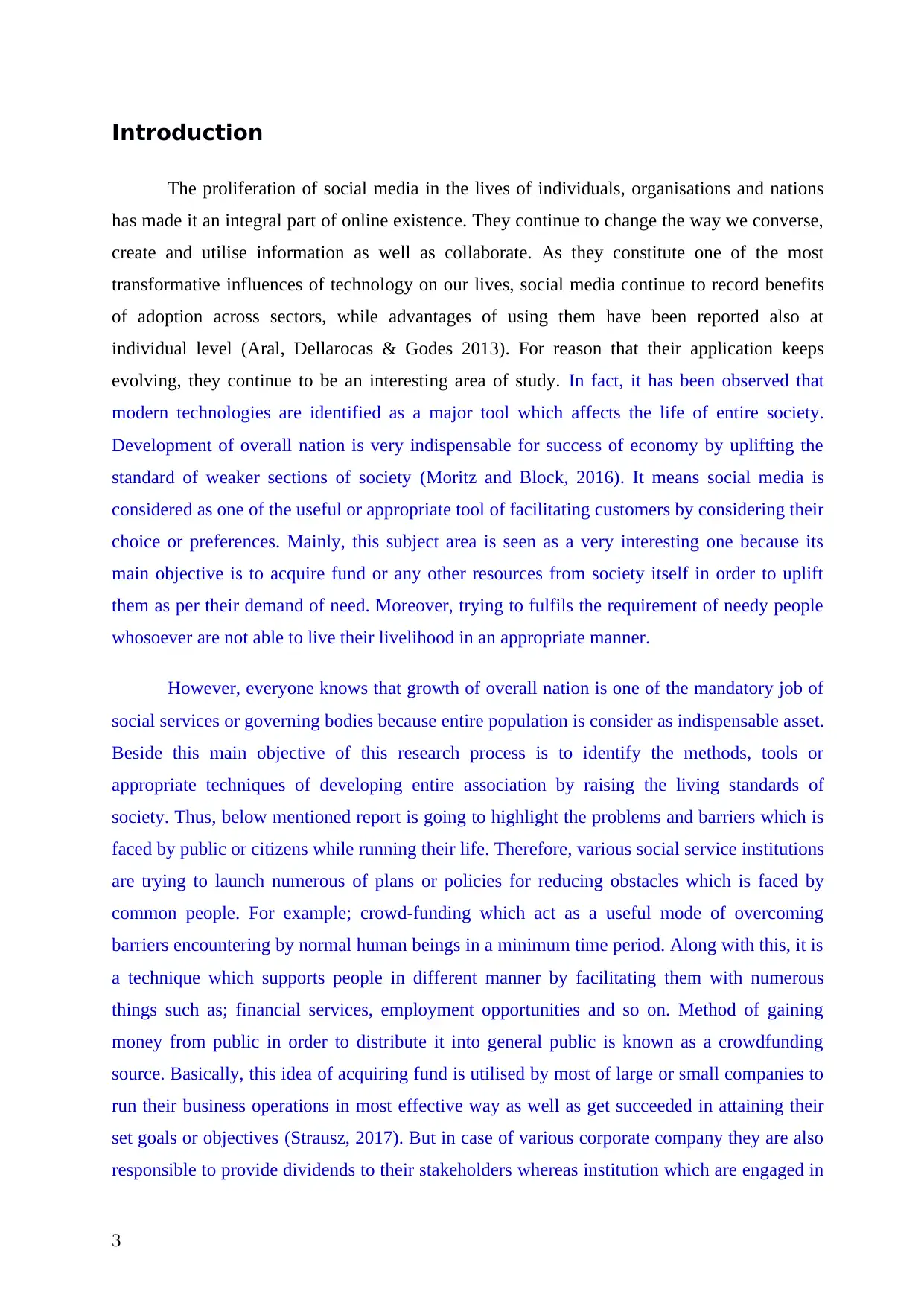
Introduction
The proliferation of social media in the lives of individuals, organisations and nations
has made it an integral part of online existence. They continue to change the way we converse,
create and utilise information as well as collaborate. As they constitute one of the most
transformative influences of technology on our lives, social media continue to record benefits
of adoption across sectors, while advantages of using them have been reported also at
individual level (Aral, Dellarocas & Godes 2013). For reason that their application keeps
evolving, they continue to be an interesting area of study. In fact, it has been observed that
modern technologies are identified as a major tool which affects the life of entire society.
Development of overall nation is very indispensable for success of economy by uplifting the
standard of weaker sections of society (Moritz and Block, 2016). It means social media is
considered as one of the useful or appropriate tool of facilitating customers by considering their
choice or preferences. Mainly, this subject area is seen as a very interesting one because its
main objective is to acquire fund or any other resources from society itself in order to uplift
them as per their demand of need. Moreover, trying to fulfils the requirement of needy people
whosoever are not able to live their livelihood in an appropriate manner.
However, everyone knows that growth of overall nation is one of the mandatory job of
social services or governing bodies because entire population is consider as indispensable asset.
Beside this main objective of this research process is to identify the methods, tools or
appropriate techniques of developing entire association by raising the living standards of
society. Thus, below mentioned report is going to highlight the problems and barriers which is
faced by public or citizens while running their life. Therefore, various social service institutions
are trying to launch numerous of plans or policies for reducing obstacles which is faced by
common people. For example; crowd-funding which act as a useful mode of overcoming
barriers encountering by normal human beings in a minimum time period. Along with this, it is
a technique which supports people in different manner by facilitating them with numerous
things such as; financial services, employment opportunities and so on. Method of gaining
money from public in order to distribute it into general public is known as a crowdfunding
source. Basically, this idea of acquiring fund is utilised by most of large or small companies to
run their business operations in most effective way as well as get succeeded in attaining their
set goals or objectives (Strausz, 2017). But in case of various corporate company they are also
responsible to provide dividends to their stakeholders whereas institution which are engaged in
3
The proliferation of social media in the lives of individuals, organisations and nations
has made it an integral part of online existence. They continue to change the way we converse,
create and utilise information as well as collaborate. As they constitute one of the most
transformative influences of technology on our lives, social media continue to record benefits
of adoption across sectors, while advantages of using them have been reported also at
individual level (Aral, Dellarocas & Godes 2013). For reason that their application keeps
evolving, they continue to be an interesting area of study. In fact, it has been observed that
modern technologies are identified as a major tool which affects the life of entire society.
Development of overall nation is very indispensable for success of economy by uplifting the
standard of weaker sections of society (Moritz and Block, 2016). It means social media is
considered as one of the useful or appropriate tool of facilitating customers by considering their
choice or preferences. Mainly, this subject area is seen as a very interesting one because its
main objective is to acquire fund or any other resources from society itself in order to uplift
them as per their demand of need. Moreover, trying to fulfils the requirement of needy people
whosoever are not able to live their livelihood in an appropriate manner.
However, everyone knows that growth of overall nation is one of the mandatory job of
social services or governing bodies because entire population is consider as indispensable asset.
Beside this main objective of this research process is to identify the methods, tools or
appropriate techniques of developing entire association by raising the living standards of
society. Thus, below mentioned report is going to highlight the problems and barriers which is
faced by public or citizens while running their life. Therefore, various social service institutions
are trying to launch numerous of plans or policies for reducing obstacles which is faced by
common people. For example; crowd-funding which act as a useful mode of overcoming
barriers encountering by normal human beings in a minimum time period. Along with this, it is
a technique which supports people in different manner by facilitating them with numerous
things such as; financial services, employment opportunities and so on. Method of gaining
money from public in order to distribute it into general public is known as a crowdfunding
source. Basically, this idea of acquiring fund is utilised by most of large or small companies to
run their business operations in most effective way as well as get succeeded in attaining their
set goals or objectives (Strausz, 2017). But in case of various corporate company they are also
responsible to provide dividends to their stakeholders whereas institution which are engaged in
3
⊘ This is a preview!⊘
Do you want full access?
Subscribe today to unlock all pages.

Trusted by 1+ million students worldwide
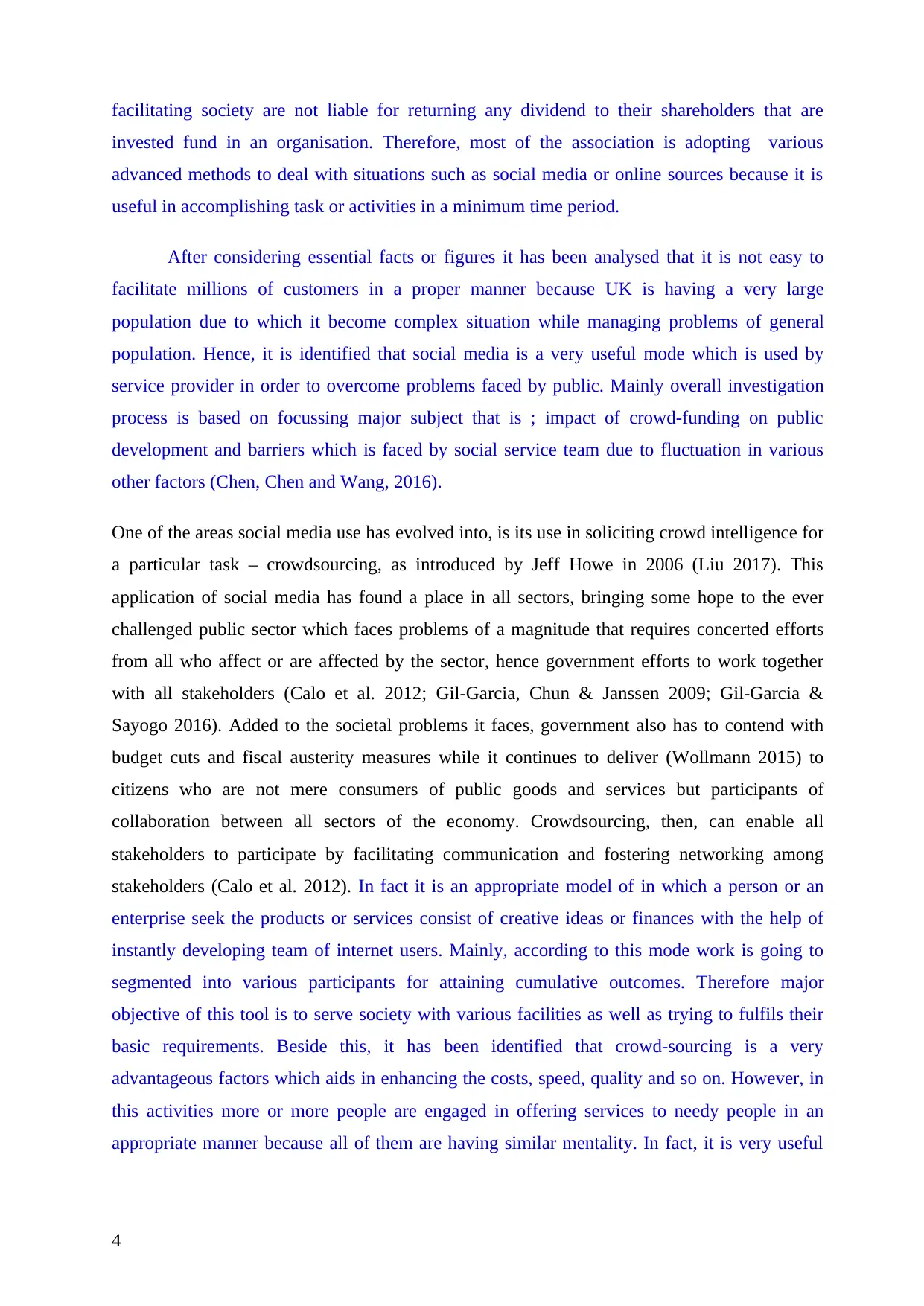
facilitating society are not liable for returning any dividend to their shareholders that are
invested fund in an organisation. Therefore, most of the association is adopting various
advanced methods to deal with situations such as social media or online sources because it is
useful in accomplishing task or activities in a minimum time period.
After considering essential facts or figures it has been analysed that it is not easy to
facilitate millions of customers in a proper manner because UK is having a very large
population due to which it become complex situation while managing problems of general
population. Hence, it is identified that social media is a very useful mode which is used by
service provider in order to overcome problems faced by public. Mainly overall investigation
process is based on focussing major subject that is ; impact of crowd-funding on public
development and barriers which is faced by social service team due to fluctuation in various
other factors (Chen, Chen and Wang, 2016).
One of the areas social media use has evolved into, is its use in soliciting crowd intelligence for
a particular task – crowdsourcing, as introduced by Jeff Howe in 2006 (Liu 2017). This
application of social media has found a place in all sectors, bringing some hope to the ever
challenged public sector which faces problems of a magnitude that requires concerted efforts
from all who affect or are affected by the sector, hence government efforts to work together
with all stakeholders (Calo et al. 2012; Gil-Garcia, Chun & Janssen 2009; Gil-Garcia &
Sayogo 2016). Added to the societal problems it faces, government also has to contend with
budget cuts and fiscal austerity measures while it continues to deliver (Wollmann 2015) to
citizens who are not mere consumers of public goods and services but participants of
collaboration between all sectors of the economy. Crowdsourcing, then, can enable all
stakeholders to participate by facilitating communication and fostering networking among
stakeholders (Calo et al. 2012). In fact it is an appropriate model of in which a person or an
enterprise seek the products or services consist of creative ideas or finances with the help of
instantly developing team of internet users. Mainly, according to this mode work is going to
segmented into various participants for attaining cumulative outcomes. Therefore major
objective of this tool is to serve society with various facilities as well as trying to fulfils their
basic requirements. Beside this, it has been identified that crowd-sourcing is a very
advantageous factors which aids in enhancing the costs, speed, quality and so on. However, in
this activities more or more people are engaged in offering services to needy people in an
appropriate manner because all of them are having similar mentality. In fact, it is very useful
4
invested fund in an organisation. Therefore, most of the association is adopting various
advanced methods to deal with situations such as social media or online sources because it is
useful in accomplishing task or activities in a minimum time period.
After considering essential facts or figures it has been analysed that it is not easy to
facilitate millions of customers in a proper manner because UK is having a very large
population due to which it become complex situation while managing problems of general
population. Hence, it is identified that social media is a very useful mode which is used by
service provider in order to overcome problems faced by public. Mainly overall investigation
process is based on focussing major subject that is ; impact of crowd-funding on public
development and barriers which is faced by social service team due to fluctuation in various
other factors (Chen, Chen and Wang, 2016).
One of the areas social media use has evolved into, is its use in soliciting crowd intelligence for
a particular task – crowdsourcing, as introduced by Jeff Howe in 2006 (Liu 2017). This
application of social media has found a place in all sectors, bringing some hope to the ever
challenged public sector which faces problems of a magnitude that requires concerted efforts
from all who affect or are affected by the sector, hence government efforts to work together
with all stakeholders (Calo et al. 2012; Gil-Garcia, Chun & Janssen 2009; Gil-Garcia &
Sayogo 2016). Added to the societal problems it faces, government also has to contend with
budget cuts and fiscal austerity measures while it continues to deliver (Wollmann 2015) to
citizens who are not mere consumers of public goods and services but participants of
collaboration between all sectors of the economy. Crowdsourcing, then, can enable all
stakeholders to participate by facilitating communication and fostering networking among
stakeholders (Calo et al. 2012). In fact it is an appropriate model of in which a person or an
enterprise seek the products or services consist of creative ideas or finances with the help of
instantly developing team of internet users. Mainly, according to this mode work is going to
segmented into various participants for attaining cumulative outcomes. Therefore major
objective of this tool is to serve society with various facilities as well as trying to fulfils their
basic requirements. Beside this, it has been identified that crowd-sourcing is a very
advantageous factors which aids in enhancing the costs, speed, quality and so on. However, in
this activities more or more people are engaged in offering services to needy people in an
appropriate manner because all of them are having similar mentality. In fact, it is very useful
4
Paraphrase This Document
Need a fresh take? Get an instant paraphrase of this document with our AI Paraphraser
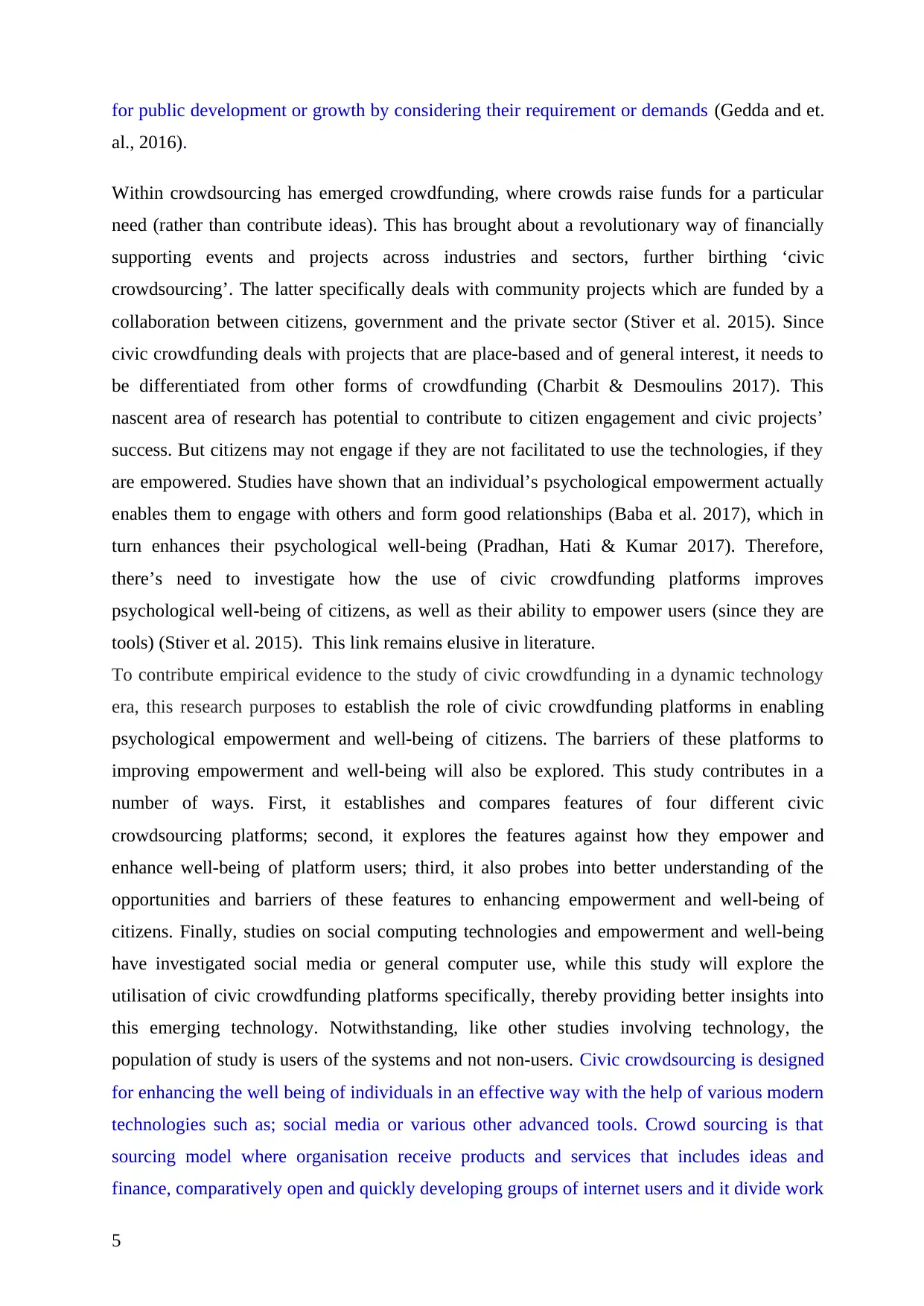
for public development or growth by considering their requirement or demands (Gedda and et.
al., 2016).
Within crowdsourcing has emerged crowdfunding, where crowds raise funds for a particular
need (rather than contribute ideas). This has brought about a revolutionary way of financially
supporting events and projects across industries and sectors, further birthing ‘civic
crowdsourcing’. The latter specifically deals with community projects which are funded by a
collaboration between citizens, government and the private sector (Stiver et al. 2015). Since
civic crowdfunding deals with projects that are place-based and of general interest, it needs to
be differentiated from other forms of crowdfunding (Charbit & Desmoulins 2017). This
nascent area of research has potential to contribute to citizen engagement and civic projects’
success. But citizens may not engage if they are not facilitated to use the technologies, if they
are empowered. Studies have shown that an individual’s psychological empowerment actually
enables them to engage with others and form good relationships (Baba et al. 2017), which in
turn enhances their psychological well-being (Pradhan, Hati & Kumar 2017). Therefore,
there’s need to investigate how the use of civic crowdfunding platforms improves
psychological well-being of citizens, as well as their ability to empower users (since they are
tools) (Stiver et al. 2015). This link remains elusive in literature.
To contribute empirical evidence to the study of civic crowdfunding in a dynamic technology
era, this research purposes to establish the role of civic crowdfunding platforms in enabling
psychological empowerment and well-being of citizens. The barriers of these platforms to
improving empowerment and well-being will also be explored. This study contributes in a
number of ways. First, it establishes and compares features of four different civic
crowdsourcing platforms; second, it explores the features against how they empower and
enhance well-being of platform users; third, it also probes into better understanding of the
opportunities and barriers of these features to enhancing empowerment and well-being of
citizens. Finally, studies on social computing technologies and empowerment and well-being
have investigated social media or general computer use, while this study will explore the
utilisation of civic crowdfunding platforms specifically, thereby providing better insights into
this emerging technology. Notwithstanding, like other studies involving technology, the
population of study is users of the systems and not non-users. Civic crowdsourcing is designed
for enhancing the well being of individuals in an effective way with the help of various modern
technologies such as; social media or various other advanced tools. Crowd sourcing is that
sourcing model where organisation receive products and services that includes ideas and
finance, comparatively open and quickly developing groups of internet users and it divide work
5
al., 2016).
Within crowdsourcing has emerged crowdfunding, where crowds raise funds for a particular
need (rather than contribute ideas). This has brought about a revolutionary way of financially
supporting events and projects across industries and sectors, further birthing ‘civic
crowdsourcing’. The latter specifically deals with community projects which are funded by a
collaboration between citizens, government and the private sector (Stiver et al. 2015). Since
civic crowdfunding deals with projects that are place-based and of general interest, it needs to
be differentiated from other forms of crowdfunding (Charbit & Desmoulins 2017). This
nascent area of research has potential to contribute to citizen engagement and civic projects’
success. But citizens may not engage if they are not facilitated to use the technologies, if they
are empowered. Studies have shown that an individual’s psychological empowerment actually
enables them to engage with others and form good relationships (Baba et al. 2017), which in
turn enhances their psychological well-being (Pradhan, Hati & Kumar 2017). Therefore,
there’s need to investigate how the use of civic crowdfunding platforms improves
psychological well-being of citizens, as well as their ability to empower users (since they are
tools) (Stiver et al. 2015). This link remains elusive in literature.
To contribute empirical evidence to the study of civic crowdfunding in a dynamic technology
era, this research purposes to establish the role of civic crowdfunding platforms in enabling
psychological empowerment and well-being of citizens. The barriers of these platforms to
improving empowerment and well-being will also be explored. This study contributes in a
number of ways. First, it establishes and compares features of four different civic
crowdsourcing platforms; second, it explores the features against how they empower and
enhance well-being of platform users; third, it also probes into better understanding of the
opportunities and barriers of these features to enhancing empowerment and well-being of
citizens. Finally, studies on social computing technologies and empowerment and well-being
have investigated social media or general computer use, while this study will explore the
utilisation of civic crowdfunding platforms specifically, thereby providing better insights into
this emerging technology. Notwithstanding, like other studies involving technology, the
population of study is users of the systems and not non-users. Civic crowdsourcing is designed
for enhancing the well being of individuals in an effective way with the help of various modern
technologies such as; social media or various other advanced tools. Crowd sourcing is that
sourcing model where organisation receive products and services that includes ideas and
finance, comparatively open and quickly developing groups of internet users and it divide work
5
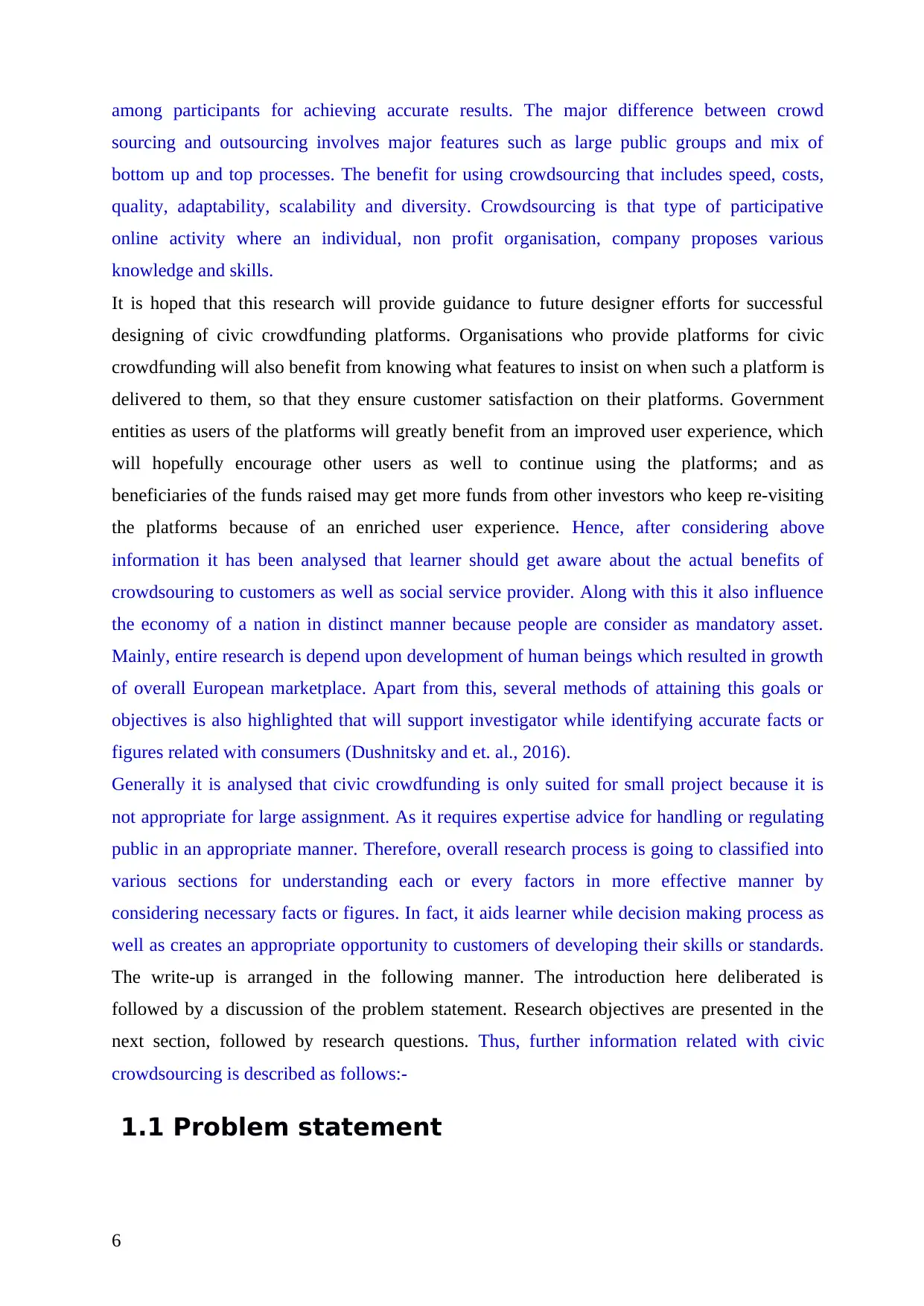
among participants for achieving accurate results. The major difference between crowd
sourcing and outsourcing involves major features such as large public groups and mix of
bottom up and top processes. The benefit for using crowdsourcing that includes speed, costs,
quality, adaptability, scalability and diversity. Crowdsourcing is that type of participative
online activity where an individual, non profit organisation, company proposes various
knowledge and skills.
It is hoped that this research will provide guidance to future designer efforts for successful
designing of civic crowdfunding platforms. Organisations who provide platforms for civic
crowdfunding will also benefit from knowing what features to insist on when such a platform is
delivered to them, so that they ensure customer satisfaction on their platforms. Government
entities as users of the platforms will greatly benefit from an improved user experience, which
will hopefully encourage other users as well to continue using the platforms; and as
beneficiaries of the funds raised may get more funds from other investors who keep re-visiting
the platforms because of an enriched user experience. Hence, after considering above
information it has been analysed that learner should get aware about the actual benefits of
crowdsouring to customers as well as social service provider. Along with this it also influence
the economy of a nation in distinct manner because people are consider as mandatory asset.
Mainly, entire research is depend upon development of human beings which resulted in growth
of overall European marketplace. Apart from this, several methods of attaining this goals or
objectives is also highlighted that will support investigator while identifying accurate facts or
figures related with consumers (Dushnitsky and et. al., 2016).
Generally it is analysed that civic crowdfunding is only suited for small project because it is
not appropriate for large assignment. As it requires expertise advice for handling or regulating
public in an appropriate manner. Therefore, overall research process is going to classified into
various sections for understanding each or every factors in more effective manner by
considering necessary facts or figures. In fact, it aids learner while decision making process as
well as creates an appropriate opportunity to customers of developing their skills or standards.
The write-up is arranged in the following manner. The introduction here deliberated is
followed by a discussion of the problem statement. Research objectives are presented in the
next section, followed by research questions. Thus, further information related with civic
crowdsourcing is described as follows:-
1.1 Problem statement
6
sourcing and outsourcing involves major features such as large public groups and mix of
bottom up and top processes. The benefit for using crowdsourcing that includes speed, costs,
quality, adaptability, scalability and diversity. Crowdsourcing is that type of participative
online activity where an individual, non profit organisation, company proposes various
knowledge and skills.
It is hoped that this research will provide guidance to future designer efforts for successful
designing of civic crowdfunding platforms. Organisations who provide platforms for civic
crowdfunding will also benefit from knowing what features to insist on when such a platform is
delivered to them, so that they ensure customer satisfaction on their platforms. Government
entities as users of the platforms will greatly benefit from an improved user experience, which
will hopefully encourage other users as well to continue using the platforms; and as
beneficiaries of the funds raised may get more funds from other investors who keep re-visiting
the platforms because of an enriched user experience. Hence, after considering above
information it has been analysed that learner should get aware about the actual benefits of
crowdsouring to customers as well as social service provider. Along with this it also influence
the economy of a nation in distinct manner because people are consider as mandatory asset.
Mainly, entire research is depend upon development of human beings which resulted in growth
of overall European marketplace. Apart from this, several methods of attaining this goals or
objectives is also highlighted that will support investigator while identifying accurate facts or
figures related with consumers (Dushnitsky and et. al., 2016).
Generally it is analysed that civic crowdfunding is only suited for small project because it is
not appropriate for large assignment. As it requires expertise advice for handling or regulating
public in an appropriate manner. Therefore, overall research process is going to classified into
various sections for understanding each or every factors in more effective manner by
considering necessary facts or figures. In fact, it aids learner while decision making process as
well as creates an appropriate opportunity to customers of developing their skills or standards.
The write-up is arranged in the following manner. The introduction here deliberated is
followed by a discussion of the problem statement. Research objectives are presented in the
next section, followed by research questions. Thus, further information related with civic
crowdsourcing is described as follows:-
1.1 Problem statement
6
⊘ This is a preview!⊘
Do you want full access?
Subscribe today to unlock all pages.

Trusted by 1+ million students worldwide
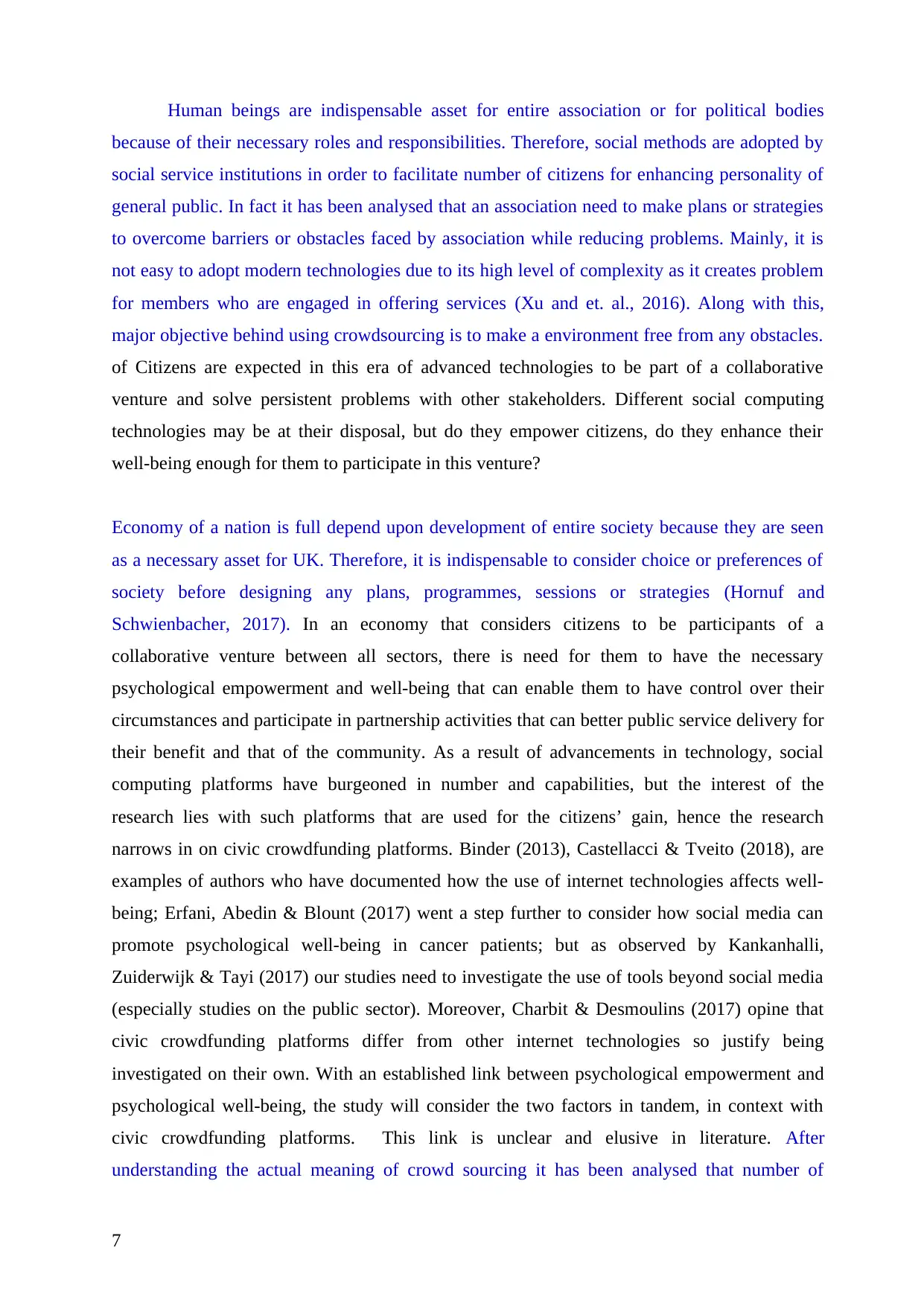
Human beings are indispensable asset for entire association or for political bodies
because of their necessary roles and responsibilities. Therefore, social methods are adopted by
social service institutions in order to facilitate number of citizens for enhancing personality of
general public. In fact it has been analysed that an association need to make plans or strategies
to overcome barriers or obstacles faced by association while reducing problems. Mainly, it is
not easy to adopt modern technologies due to its high level of complexity as it creates problem
for members who are engaged in offering services (Xu and et. al., 2016). Along with this,
major objective behind using crowdsourcing is to make a environment free from any obstacles.
of Citizens are expected in this era of advanced technologies to be part of a collaborative
venture and solve persistent problems with other stakeholders. Different social computing
technologies may be at their disposal, but do they empower citizens, do they enhance their
well-being enough for them to participate in this venture?
Economy of a nation is full depend upon development of entire society because they are seen
as a necessary asset for UK. Therefore, it is indispensable to consider choice or preferences of
society before designing any plans, programmes, sessions or strategies (Hornuf and
Schwienbacher, 2017). In an economy that considers citizens to be participants of a
collaborative venture between all sectors, there is need for them to have the necessary
psychological empowerment and well-being that can enable them to have control over their
circumstances and participate in partnership activities that can better public service delivery for
their benefit and that of the community. As a result of advancements in technology, social
computing platforms have burgeoned in number and capabilities, but the interest of the
research lies with such platforms that are used for the citizens’ gain, hence the research
narrows in on civic crowdfunding platforms. Binder (2013), Castellacci & Tveito (2018), are
examples of authors who have documented how the use of internet technologies affects well-
being; Erfani, Abedin & Blount (2017) went a step further to consider how social media can
promote psychological well-being in cancer patients; but as observed by Kankanhalli,
Zuiderwijk & Tayi (2017) our studies need to investigate the use of tools beyond social media
(especially studies on the public sector). Moreover, Charbit & Desmoulins (2017) opine that
civic crowdfunding platforms differ from other internet technologies so justify being
investigated on their own. With an established link between psychological empowerment and
psychological well-being, the study will consider the two factors in tandem, in context with
civic crowdfunding platforms. This link is unclear and elusive in literature. After
understanding the actual meaning of crowd sourcing it has been analysed that number of
7
because of their necessary roles and responsibilities. Therefore, social methods are adopted by
social service institutions in order to facilitate number of citizens for enhancing personality of
general public. In fact it has been analysed that an association need to make plans or strategies
to overcome barriers or obstacles faced by association while reducing problems. Mainly, it is
not easy to adopt modern technologies due to its high level of complexity as it creates problem
for members who are engaged in offering services (Xu and et. al., 2016). Along with this,
major objective behind using crowdsourcing is to make a environment free from any obstacles.
of Citizens are expected in this era of advanced technologies to be part of a collaborative
venture and solve persistent problems with other stakeholders. Different social computing
technologies may be at their disposal, but do they empower citizens, do they enhance their
well-being enough for them to participate in this venture?
Economy of a nation is full depend upon development of entire society because they are seen
as a necessary asset for UK. Therefore, it is indispensable to consider choice or preferences of
society before designing any plans, programmes, sessions or strategies (Hornuf and
Schwienbacher, 2017). In an economy that considers citizens to be participants of a
collaborative venture between all sectors, there is need for them to have the necessary
psychological empowerment and well-being that can enable them to have control over their
circumstances and participate in partnership activities that can better public service delivery for
their benefit and that of the community. As a result of advancements in technology, social
computing platforms have burgeoned in number and capabilities, but the interest of the
research lies with such platforms that are used for the citizens’ gain, hence the research
narrows in on civic crowdfunding platforms. Binder (2013), Castellacci & Tveito (2018), are
examples of authors who have documented how the use of internet technologies affects well-
being; Erfani, Abedin & Blount (2017) went a step further to consider how social media can
promote psychological well-being in cancer patients; but as observed by Kankanhalli,
Zuiderwijk & Tayi (2017) our studies need to investigate the use of tools beyond social media
(especially studies on the public sector). Moreover, Charbit & Desmoulins (2017) opine that
civic crowdfunding platforms differ from other internet technologies so justify being
investigated on their own. With an established link between psychological empowerment and
psychological well-being, the study will consider the two factors in tandem, in context with
civic crowdfunding platforms. This link is unclear and elusive in literature. After
understanding the actual meaning of crowd sourcing it has been analysed that number of
7
Paraphrase This Document
Need a fresh take? Get an instant paraphrase of this document with our AI Paraphraser
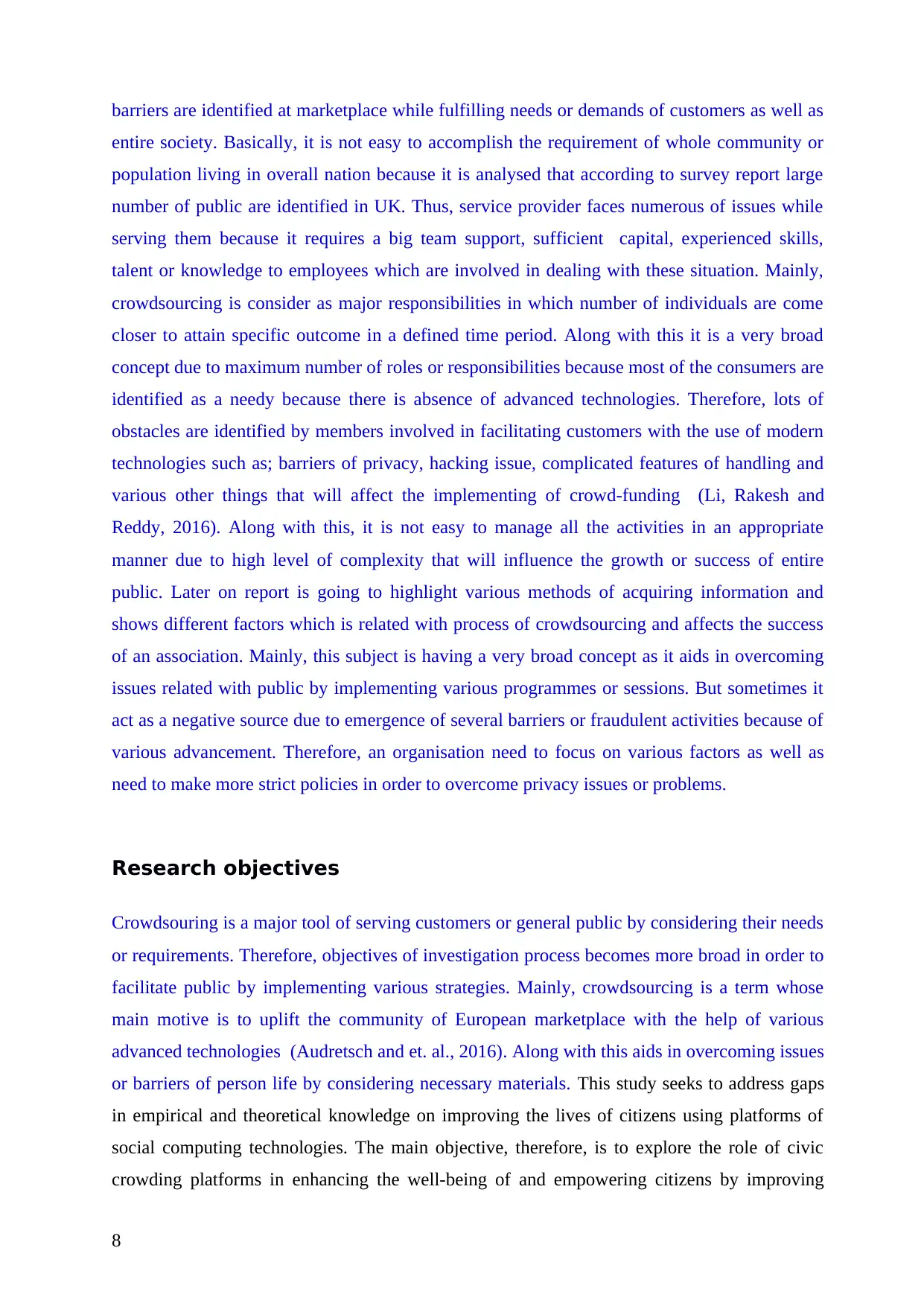
barriers are identified at marketplace while fulfilling needs or demands of customers as well as
entire society. Basically, it is not easy to accomplish the requirement of whole community or
population living in overall nation because it is analysed that according to survey report large
number of public are identified in UK. Thus, service provider faces numerous of issues while
serving them because it requires a big team support, sufficient capital, experienced skills,
talent or knowledge to employees which are involved in dealing with these situation. Mainly,
crowdsourcing is consider as major responsibilities in which number of individuals are come
closer to attain specific outcome in a defined time period. Along with this it is a very broad
concept due to maximum number of roles or responsibilities because most of the consumers are
identified as a needy because there is absence of advanced technologies. Therefore, lots of
obstacles are identified by members involved in facilitating customers with the use of modern
technologies such as; barriers of privacy, hacking issue, complicated features of handling and
various other things that will affect the implementing of crowd-funding (Li, Rakesh and
Reddy, 2016). Along with this, it is not easy to manage all the activities in an appropriate
manner due to high level of complexity that will influence the growth or success of entire
public. Later on report is going to highlight various methods of acquiring information and
shows different factors which is related with process of crowdsourcing and affects the success
of an association. Mainly, this subject is having a very broad concept as it aids in overcoming
issues related with public by implementing various programmes or sessions. But sometimes it
act as a negative source due to emergence of several barriers or fraudulent activities because of
various advancement. Therefore, an organisation need to focus on various factors as well as
need to make more strict policies in order to overcome privacy issues or problems.
Research objectives
Crowdsouring is a major tool of serving customers or general public by considering their needs
or requirements. Therefore, objectives of investigation process becomes more broad in order to
facilitate public by implementing various strategies. Mainly, crowdsourcing is a term whose
main motive is to uplift the community of European marketplace with the help of various
advanced technologies (Audretsch and et. al., 2016). Along with this aids in overcoming issues
or barriers of person life by considering necessary materials. This study seeks to address gaps
in empirical and theoretical knowledge on improving the lives of citizens using platforms of
social computing technologies. The main objective, therefore, is to explore the role of civic
crowding platforms in enhancing the well-being of and empowering citizens by improving
8
entire society. Basically, it is not easy to accomplish the requirement of whole community or
population living in overall nation because it is analysed that according to survey report large
number of public are identified in UK. Thus, service provider faces numerous of issues while
serving them because it requires a big team support, sufficient capital, experienced skills,
talent or knowledge to employees which are involved in dealing with these situation. Mainly,
crowdsourcing is consider as major responsibilities in which number of individuals are come
closer to attain specific outcome in a defined time period. Along with this it is a very broad
concept due to maximum number of roles or responsibilities because most of the consumers are
identified as a needy because there is absence of advanced technologies. Therefore, lots of
obstacles are identified by members involved in facilitating customers with the use of modern
technologies such as; barriers of privacy, hacking issue, complicated features of handling and
various other things that will affect the implementing of crowd-funding (Li, Rakesh and
Reddy, 2016). Along with this, it is not easy to manage all the activities in an appropriate
manner due to high level of complexity that will influence the growth or success of entire
public. Later on report is going to highlight various methods of acquiring information and
shows different factors which is related with process of crowdsourcing and affects the success
of an association. Mainly, this subject is having a very broad concept as it aids in overcoming
issues related with public by implementing various programmes or sessions. But sometimes it
act as a negative source due to emergence of several barriers or fraudulent activities because of
various advancement. Therefore, an organisation need to focus on various factors as well as
need to make more strict policies in order to overcome privacy issues or problems.
Research objectives
Crowdsouring is a major tool of serving customers or general public by considering their needs
or requirements. Therefore, objectives of investigation process becomes more broad in order to
facilitate public by implementing various strategies. Mainly, crowdsourcing is a term whose
main motive is to uplift the community of European marketplace with the help of various
advanced technologies (Audretsch and et. al., 2016). Along with this aids in overcoming issues
or barriers of person life by considering necessary materials. This study seeks to address gaps
in empirical and theoretical knowledge on improving the lives of citizens using platforms of
social computing technologies. The main objective, therefore, is to explore the role of civic
crowding platforms in enhancing the well-being of and empowering citizens by improving
8
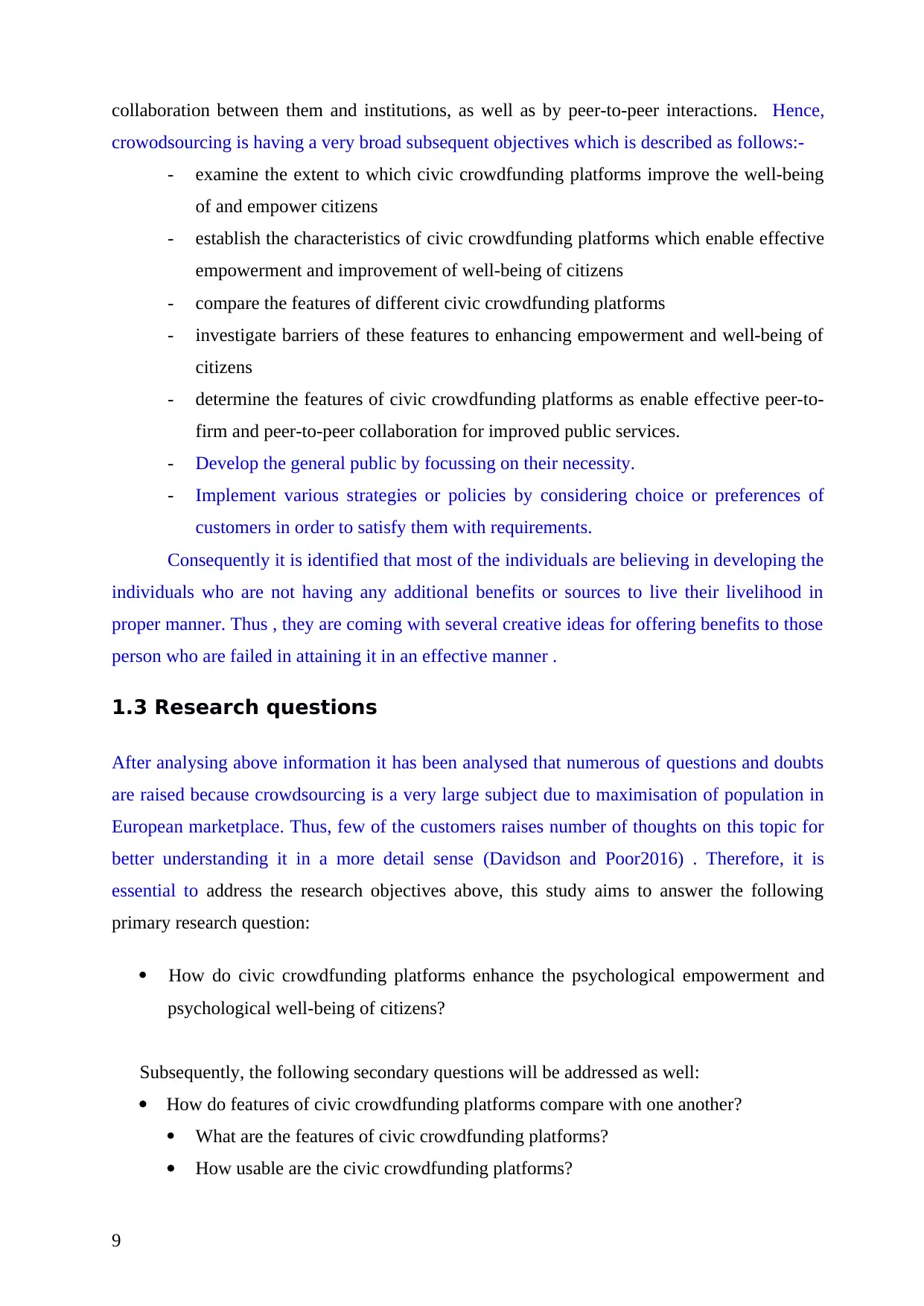
collaboration between them and institutions, as well as by peer-to-peer interactions. Hence,
crowodsourcing is having a very broad subsequent objectives which is described as follows:-
- examine the extent to which civic crowdfunding platforms improve the well-being
of and empower citizens
- establish the characteristics of civic crowdfunding platforms which enable effective
empowerment and improvement of well-being of citizens
- compare the features of different civic crowdfunding platforms
- investigate barriers of these features to enhancing empowerment and well-being of
citizens
- determine the features of civic crowdfunding platforms as enable effective peer-to-
firm and peer-to-peer collaboration for improved public services.
- Develop the general public by focussing on their necessity.
- Implement various strategies or policies by considering choice or preferences of
customers in order to satisfy them with requirements.
Consequently it is identified that most of the individuals are believing in developing the
individuals who are not having any additional benefits or sources to live their livelihood in
proper manner. Thus , they are coming with several creative ideas for offering benefits to those
person who are failed in attaining it in an effective manner .
1.3 Research questions
After analysing above information it has been analysed that numerous of questions and doubts
are raised because crowdsourcing is a very large subject due to maximisation of population in
European marketplace. Thus, few of the customers raises number of thoughts on this topic for
better understanding it in a more detail sense (Davidson and Poor2016) . Therefore, it is
essential to address the research objectives above, this study aims to answer the following
primary research question:
How do civic crowdfunding platforms enhance the psychological empowerment and
psychological well-being of citizens?
Subsequently, the following secondary questions will be addressed as well:
How do features of civic crowdfunding platforms compare with one another?
What are the features of civic crowdfunding platforms?
How usable are the civic crowdfunding platforms?
9
crowodsourcing is having a very broad subsequent objectives which is described as follows:-
- examine the extent to which civic crowdfunding platforms improve the well-being
of and empower citizens
- establish the characteristics of civic crowdfunding platforms which enable effective
empowerment and improvement of well-being of citizens
- compare the features of different civic crowdfunding platforms
- investigate barriers of these features to enhancing empowerment and well-being of
citizens
- determine the features of civic crowdfunding platforms as enable effective peer-to-
firm and peer-to-peer collaboration for improved public services.
- Develop the general public by focussing on their necessity.
- Implement various strategies or policies by considering choice or preferences of
customers in order to satisfy them with requirements.
Consequently it is identified that most of the individuals are believing in developing the
individuals who are not having any additional benefits or sources to live their livelihood in
proper manner. Thus , they are coming with several creative ideas for offering benefits to those
person who are failed in attaining it in an effective manner .
1.3 Research questions
After analysing above information it has been analysed that numerous of questions and doubts
are raised because crowdsourcing is a very large subject due to maximisation of population in
European marketplace. Thus, few of the customers raises number of thoughts on this topic for
better understanding it in a more detail sense (Davidson and Poor2016) . Therefore, it is
essential to address the research objectives above, this study aims to answer the following
primary research question:
How do civic crowdfunding platforms enhance the psychological empowerment and
psychological well-being of citizens?
Subsequently, the following secondary questions will be addressed as well:
How do features of civic crowdfunding platforms compare with one another?
What are the features of civic crowdfunding platforms?
How usable are the civic crowdfunding platforms?
9
⊘ This is a preview!⊘
Do you want full access?
Subscribe today to unlock all pages.

Trusted by 1+ million students worldwide
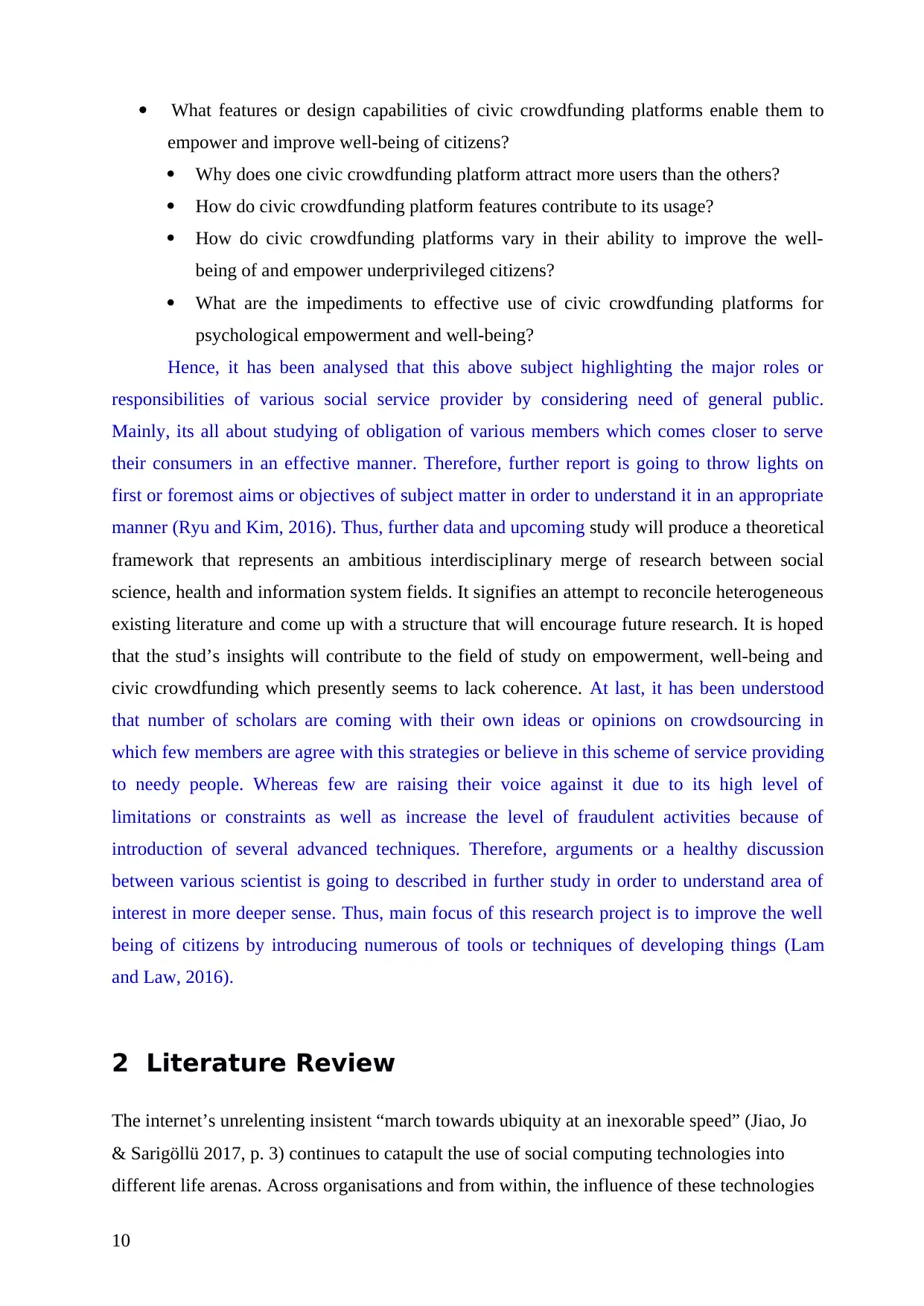
What features or design capabilities of civic crowdfunding platforms enable them to
empower and improve well-being of citizens?
Why does one civic crowdfunding platform attract more users than the others?
How do civic crowdfunding platform features contribute to its usage?
How do civic crowdfunding platforms vary in their ability to improve the well-
being of and empower underprivileged citizens?
What are the impediments to effective use of civic crowdfunding platforms for
psychological empowerment and well-being?
Hence, it has been analysed that this above subject highlighting the major roles or
responsibilities of various social service provider by considering need of general public.
Mainly, its all about studying of obligation of various members which comes closer to serve
their consumers in an effective manner. Therefore, further report is going to throw lights on
first or foremost aims or objectives of subject matter in order to understand it in an appropriate
manner (Ryu and Kim, 2016). Thus, further data and upcoming study will produce a theoretical
framework that represents an ambitious interdisciplinary merge of research between social
science, health and information system fields. It signifies an attempt to reconcile heterogeneous
existing literature and come up with a structure that will encourage future research. It is hoped
that the stud’s insights will contribute to the field of study on empowerment, well-being and
civic crowdfunding which presently seems to lack coherence. At last, it has been understood
that number of scholars are coming with their own ideas or opinions on crowdsourcing in
which few members are agree with this strategies or believe in this scheme of service providing
to needy people. Whereas few are raising their voice against it due to its high level of
limitations or constraints as well as increase the level of fraudulent activities because of
introduction of several advanced techniques. Therefore, arguments or a healthy discussion
between various scientist is going to described in further study in order to understand area of
interest in more deeper sense. Thus, main focus of this research project is to improve the well
being of citizens by introducing numerous of tools or techniques of developing things (Lam
and Law, 2016).
2 Literature Review
The internet’s unrelenting insistent “march towards ubiquity at an inexorable speed” (Jiao, Jo
& Sarigöllü 2017, p. 3) continues to catapult the use of social computing technologies into
different life arenas. Across organisations and from within, the influence of these technologies
10
empower and improve well-being of citizens?
Why does one civic crowdfunding platform attract more users than the others?
How do civic crowdfunding platform features contribute to its usage?
How do civic crowdfunding platforms vary in their ability to improve the well-
being of and empower underprivileged citizens?
What are the impediments to effective use of civic crowdfunding platforms for
psychological empowerment and well-being?
Hence, it has been analysed that this above subject highlighting the major roles or
responsibilities of various social service provider by considering need of general public.
Mainly, its all about studying of obligation of various members which comes closer to serve
their consumers in an effective manner. Therefore, further report is going to throw lights on
first or foremost aims or objectives of subject matter in order to understand it in an appropriate
manner (Ryu and Kim, 2016). Thus, further data and upcoming study will produce a theoretical
framework that represents an ambitious interdisciplinary merge of research between social
science, health and information system fields. It signifies an attempt to reconcile heterogeneous
existing literature and come up with a structure that will encourage future research. It is hoped
that the stud’s insights will contribute to the field of study on empowerment, well-being and
civic crowdfunding which presently seems to lack coherence. At last, it has been understood
that number of scholars are coming with their own ideas or opinions on crowdsourcing in
which few members are agree with this strategies or believe in this scheme of service providing
to needy people. Whereas few are raising their voice against it due to its high level of
limitations or constraints as well as increase the level of fraudulent activities because of
introduction of several advanced techniques. Therefore, arguments or a healthy discussion
between various scientist is going to described in further study in order to understand area of
interest in more deeper sense. Thus, main focus of this research project is to improve the well
being of citizens by introducing numerous of tools or techniques of developing things (Lam
and Law, 2016).
2 Literature Review
The internet’s unrelenting insistent “march towards ubiquity at an inexorable speed” (Jiao, Jo
& Sarigöllü 2017, p. 3) continues to catapult the use of social computing technologies into
different life arenas. Across organisations and from within, the influence of these technologies
10
Paraphrase This Document
Need a fresh take? Get an instant paraphrase of this document with our AI Paraphraser
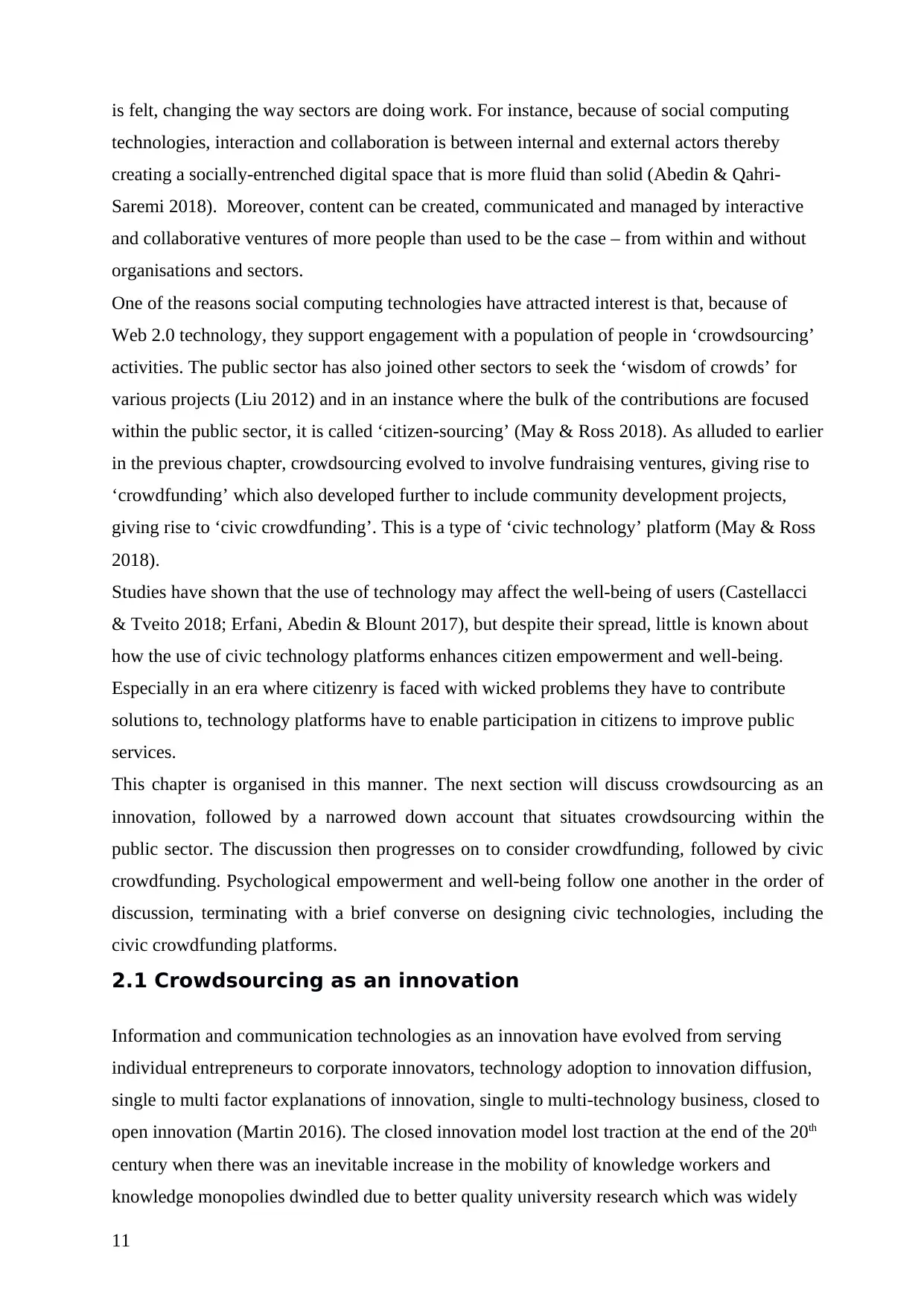
is felt, changing the way sectors are doing work. For instance, because of social computing
technologies, interaction and collaboration is between internal and external actors thereby
creating a socially-entrenched digital space that is more fluid than solid (Abedin & Qahri-
Saremi 2018). Moreover, content can be created, communicated and managed by interactive
and collaborative ventures of more people than used to be the case – from within and without
organisations and sectors.
One of the reasons social computing technologies have attracted interest is that, because of
Web 2.0 technology, they support engagement with a population of people in ‘crowdsourcing’
activities. The public sector has also joined other sectors to seek the ‘wisdom of crowds’ for
various projects (Liu 2012) and in an instance where the bulk of the contributions are focused
within the public sector, it is called ‘citizen-sourcing’ (May & Ross 2018). As alluded to earlier
in the previous chapter, crowdsourcing evolved to involve fundraising ventures, giving rise to
‘crowdfunding’ which also developed further to include community development projects,
giving rise to ‘civic crowdfunding’. This is a type of ‘civic technology’ platform (May & Ross
2018).
Studies have shown that the use of technology may affect the well-being of users (Castellacci
& Tveito 2018; Erfani, Abedin & Blount 2017), but despite their spread, little is known about
how the use of civic technology platforms enhances citizen empowerment and well-being.
Especially in an era where citizenry is faced with wicked problems they have to contribute
solutions to, technology platforms have to enable participation in citizens to improve public
services.
This chapter is organised in this manner. The next section will discuss crowdsourcing as an
innovation, followed by a narrowed down account that situates crowdsourcing within the
public sector. The discussion then progresses on to consider crowdfunding, followed by civic
crowdfunding. Psychological empowerment and well-being follow one another in the order of
discussion, terminating with a brief converse on designing civic technologies, including the
civic crowdfunding platforms.
2.1 Crowdsourcing as an innovation
Information and communication technologies as an innovation have evolved from serving
individual entrepreneurs to corporate innovators, technology adoption to innovation diffusion,
single to multi factor explanations of innovation, single to multi-technology business, closed to
open innovation (Martin 2016). The closed innovation model lost traction at the end of the 20th
century when there was an inevitable increase in the mobility of knowledge workers and
knowledge monopolies dwindled due to better quality university research which was widely
11
technologies, interaction and collaboration is between internal and external actors thereby
creating a socially-entrenched digital space that is more fluid than solid (Abedin & Qahri-
Saremi 2018). Moreover, content can be created, communicated and managed by interactive
and collaborative ventures of more people than used to be the case – from within and without
organisations and sectors.
One of the reasons social computing technologies have attracted interest is that, because of
Web 2.0 technology, they support engagement with a population of people in ‘crowdsourcing’
activities. The public sector has also joined other sectors to seek the ‘wisdom of crowds’ for
various projects (Liu 2012) and in an instance where the bulk of the contributions are focused
within the public sector, it is called ‘citizen-sourcing’ (May & Ross 2018). As alluded to earlier
in the previous chapter, crowdsourcing evolved to involve fundraising ventures, giving rise to
‘crowdfunding’ which also developed further to include community development projects,
giving rise to ‘civic crowdfunding’. This is a type of ‘civic technology’ platform (May & Ross
2018).
Studies have shown that the use of technology may affect the well-being of users (Castellacci
& Tveito 2018; Erfani, Abedin & Blount 2017), but despite their spread, little is known about
how the use of civic technology platforms enhances citizen empowerment and well-being.
Especially in an era where citizenry is faced with wicked problems they have to contribute
solutions to, technology platforms have to enable participation in citizens to improve public
services.
This chapter is organised in this manner. The next section will discuss crowdsourcing as an
innovation, followed by a narrowed down account that situates crowdsourcing within the
public sector. The discussion then progresses on to consider crowdfunding, followed by civic
crowdfunding. Psychological empowerment and well-being follow one another in the order of
discussion, terminating with a brief converse on designing civic technologies, including the
civic crowdfunding platforms.
2.1 Crowdsourcing as an innovation
Information and communication technologies as an innovation have evolved from serving
individual entrepreneurs to corporate innovators, technology adoption to innovation diffusion,
single to multi factor explanations of innovation, single to multi-technology business, closed to
open innovation (Martin 2016). The closed innovation model lost traction at the end of the 20th
century when there was an inevitable increase in the mobility of knowledge workers and
knowledge monopolies dwindled due to better quality university research which was widely
11
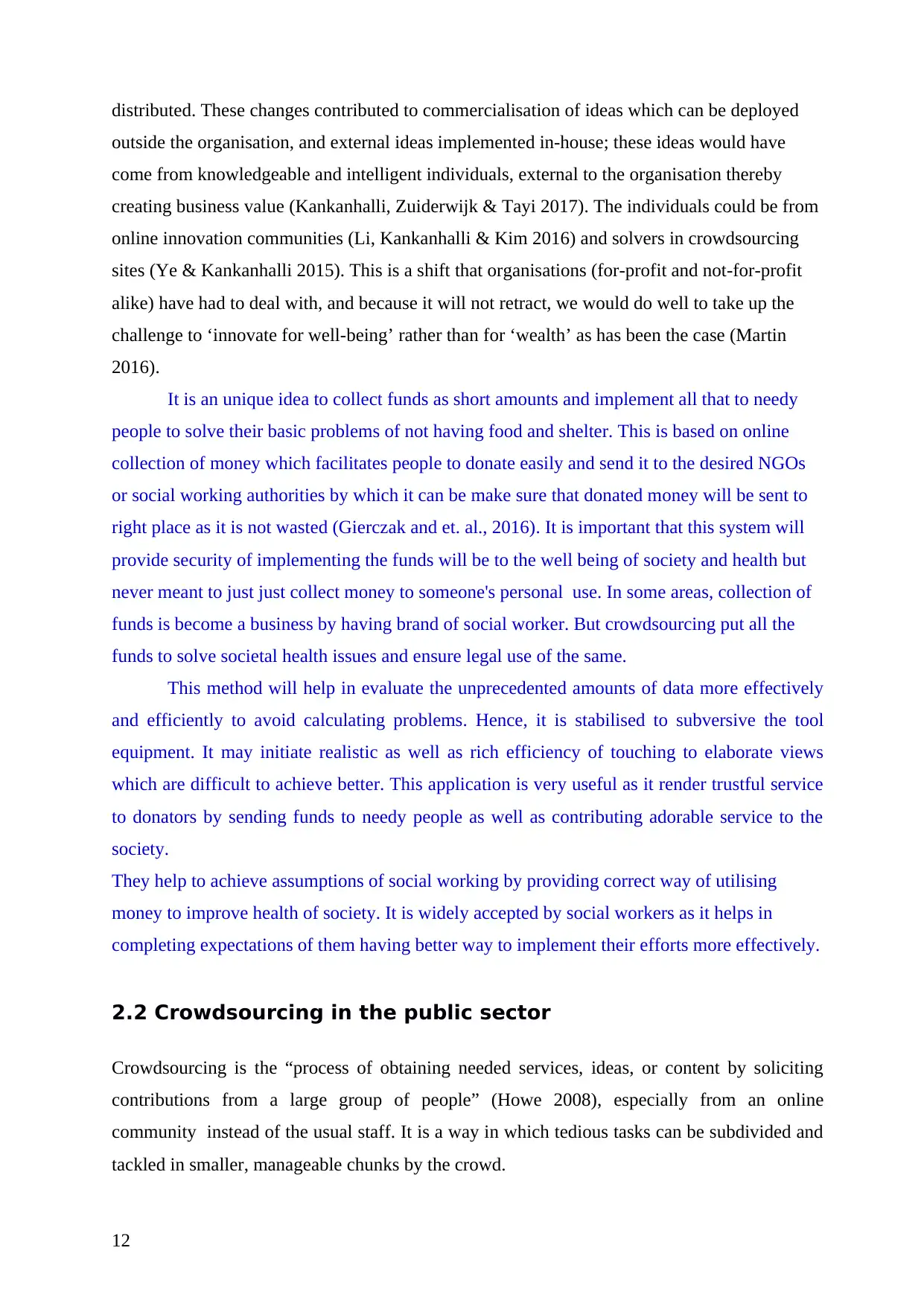
distributed. These changes contributed to commercialisation of ideas which can be deployed
outside the organisation, and external ideas implemented in-house; these ideas would have
come from knowledgeable and intelligent individuals, external to the organisation thereby
creating business value (Kankanhalli, Zuiderwijk & Tayi 2017). The individuals could be from
online innovation communities (Li, Kankanhalli & Kim 2016) and solvers in crowdsourcing
sites (Ye & Kankanhalli 2015). This is a shift that organisations (for-profit and not-for-profit
alike) have had to deal with, and because it will not retract, we would do well to take up the
challenge to ‘innovate for well-being’ rather than for ‘wealth’ as has been the case (Martin
2016).
It is an unique idea to collect funds as short amounts and implement all that to needy
people to solve their basic problems of not having food and shelter. This is based on online
collection of money which facilitates people to donate easily and send it to the desired NGOs
or social working authorities by which it can be make sure that donated money will be sent to
right place as it is not wasted (Gierczak and et. al., 2016). It is important that this system will
provide security of implementing the funds will be to the well being of society and health but
never meant to just just collect money to someone's personal use. In some areas, collection of
funds is become a business by having brand of social worker. But crowdsourcing put all the
funds to solve societal health issues and ensure legal use of the same.
This method will help in evaluate the unprecedented amounts of data more effectively
and efficiently to avoid calculating problems. Hence, it is stabilised to subversive the tool
equipment. It may initiate realistic as well as rich efficiency of touching to elaborate views
which are difficult to achieve better. This application is very useful as it render trustful service
to donators by sending funds to needy people as well as contributing adorable service to the
society.
They help to achieve assumptions of social working by providing correct way of utilising
money to improve health of society. It is widely accepted by social workers as it helps in
completing expectations of them having better way to implement their efforts more effectively.
2.2 Crowdsourcing in the public sector
Crowdsourcing is the “process of obtaining needed services, ideas, or content by soliciting
contributions from a large group of people” (Howe 2008), especially from an online
community instead of the usual staff. It is a way in which tedious tasks can be subdivided and
tackled in smaller, manageable chunks by the crowd.
12
outside the organisation, and external ideas implemented in-house; these ideas would have
come from knowledgeable and intelligent individuals, external to the organisation thereby
creating business value (Kankanhalli, Zuiderwijk & Tayi 2017). The individuals could be from
online innovation communities (Li, Kankanhalli & Kim 2016) and solvers in crowdsourcing
sites (Ye & Kankanhalli 2015). This is a shift that organisations (for-profit and not-for-profit
alike) have had to deal with, and because it will not retract, we would do well to take up the
challenge to ‘innovate for well-being’ rather than for ‘wealth’ as has been the case (Martin
2016).
It is an unique idea to collect funds as short amounts and implement all that to needy
people to solve their basic problems of not having food and shelter. This is based on online
collection of money which facilitates people to donate easily and send it to the desired NGOs
or social working authorities by which it can be make sure that donated money will be sent to
right place as it is not wasted (Gierczak and et. al., 2016). It is important that this system will
provide security of implementing the funds will be to the well being of society and health but
never meant to just just collect money to someone's personal use. In some areas, collection of
funds is become a business by having brand of social worker. But crowdsourcing put all the
funds to solve societal health issues and ensure legal use of the same.
This method will help in evaluate the unprecedented amounts of data more effectively
and efficiently to avoid calculating problems. Hence, it is stabilised to subversive the tool
equipment. It may initiate realistic as well as rich efficiency of touching to elaborate views
which are difficult to achieve better. This application is very useful as it render trustful service
to donators by sending funds to needy people as well as contributing adorable service to the
society.
They help to achieve assumptions of social working by providing correct way of utilising
money to improve health of society. It is widely accepted by social workers as it helps in
completing expectations of them having better way to implement their efforts more effectively.
2.2 Crowdsourcing in the public sector
Crowdsourcing is the “process of obtaining needed services, ideas, or content by soliciting
contributions from a large group of people” (Howe 2008), especially from an online
community instead of the usual staff. It is a way in which tedious tasks can be subdivided and
tackled in smaller, manageable chunks by the crowd.
12
⊘ This is a preview!⊘
Do you want full access?
Subscribe today to unlock all pages.

Trusted by 1+ million students worldwide
1 out of 26
Your All-in-One AI-Powered Toolkit for Academic Success.
+13062052269
info@desklib.com
Available 24*7 on WhatsApp / Email
![[object Object]](/_next/static/media/star-bottom.7253800d.svg)
Unlock your academic potential
Copyright © 2020–2025 A2Z Services. All Rights Reserved. Developed and managed by ZUCOL.